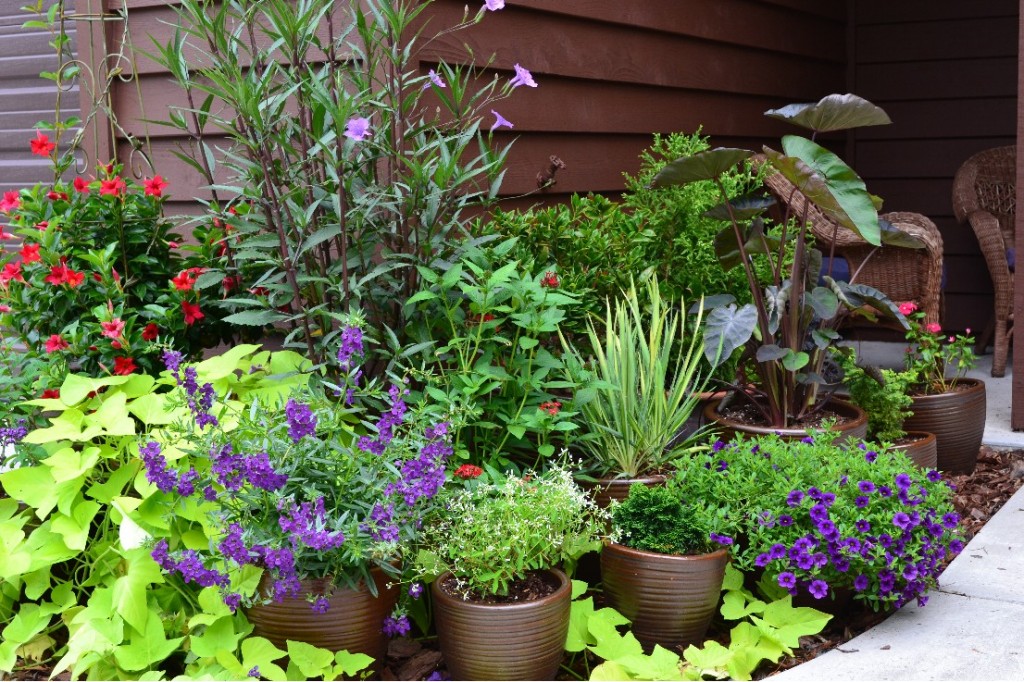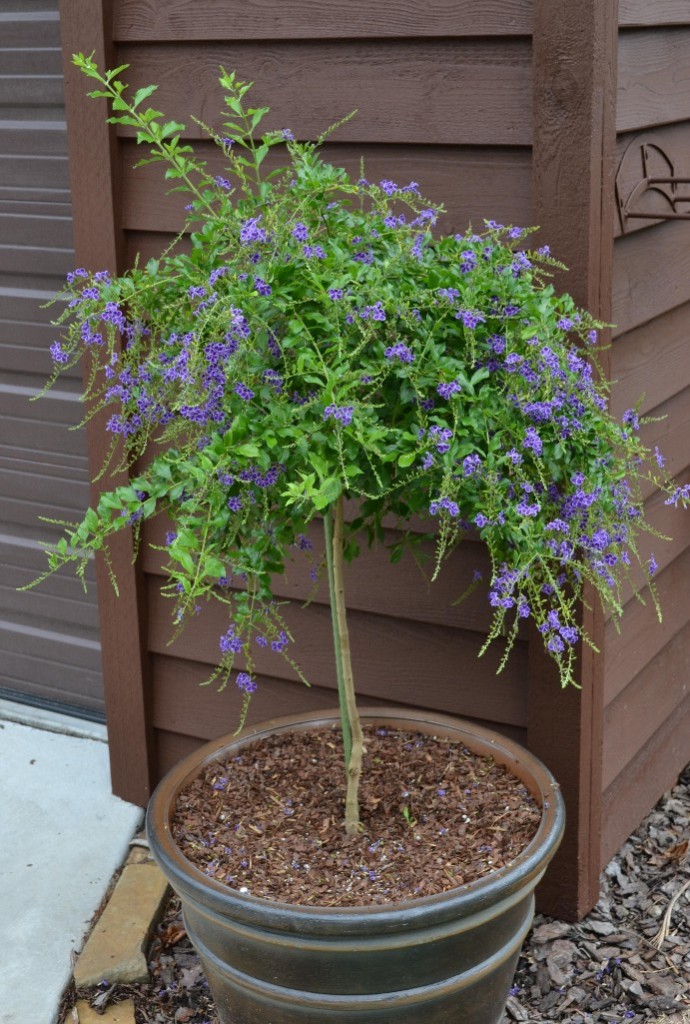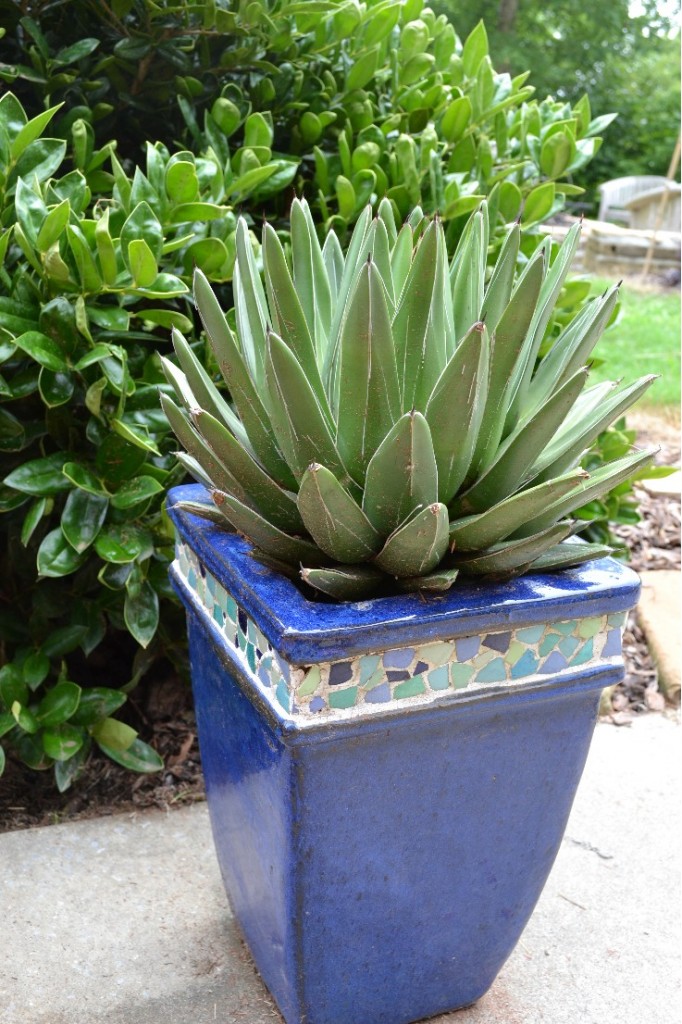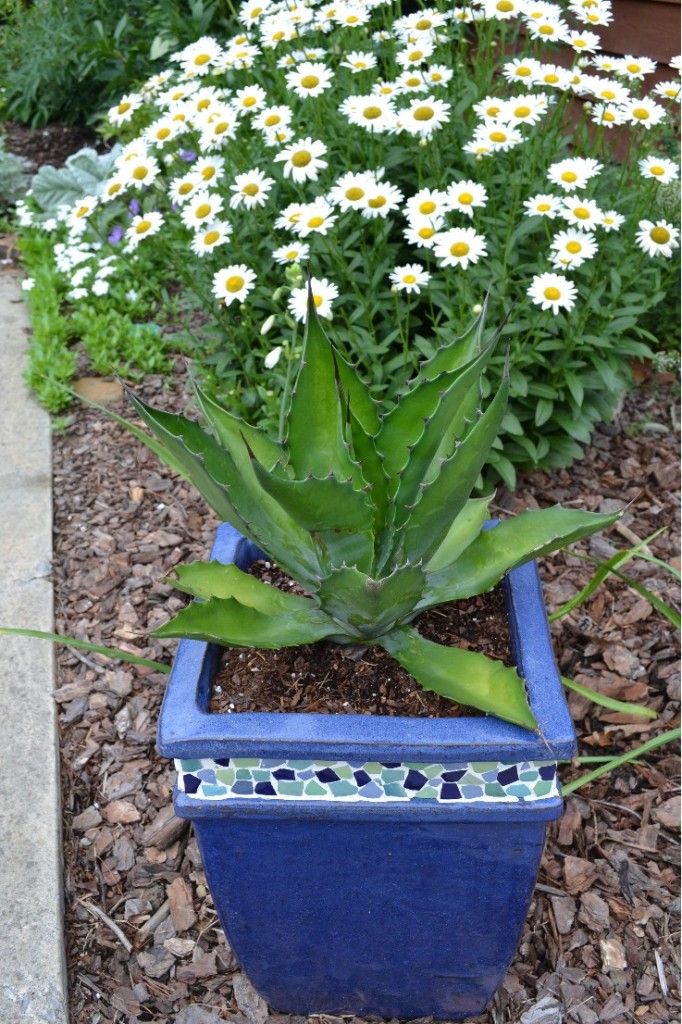
I’m very happy with the way the potted garden at the garage turned out this year. The 3 red flowered plants are: Mandevilla on the left, penta in the center and vinca on the right. The chartreuse plant is sweet potato vine (Ipomosa batatas, ‘Margarita’). The tall purple flower is Mexican petunia (Ruelia), and the tall purple leaf is elephant ear (Colocasia escelenta, ‘Diamond Head’). The spikey foliage is yucca ‘Golden Sword.’ Barely visible behind the sweet potato vine is the purple flower of heliotrope ‘Marine.’ In the front row left to right are: purple angelonia, Euphorbia ‘Diamond Frost,’ dwarf hinoki cypress (Chamaecyparis obtuse, ‘Nana’), purple Calibrachoa, and another dwarf hinoki cypress (Chamaecyparis obtuse, ‘Gold Fern’). In the far back is a Japanese cedar (Cryptomeria japonica ‘Knaptonensis’), and just in front of that is a holly (Ilex cornuta ‘Carissa’).

This is just to the right of the group you just saw. I repeated the large purple Mexican petunia, red vinca, sweet potato vine, heliotrope, Calibrachoa and Japanese cedar. I also reused the red penta, but instead of planting just 1, like I did on the left, I put 3 in a very large container. I used a different variety of angelonia on this side. The dark foliage plant in the back left is ‘Mona’ lavender (Plectranthus), and the other dark foliage plant is a dark pepper. The spiky foliage is a dwarf zebra grass (Miscanthus sinensis, ‘Gold Bar’), and there’s a red Calibrachoa planted with it. I think my favorite is the Persian shield planted just in front of the sweet potato vine.
Eddie brought over the new issue of Smith Lake Living Magazine this morning. I’m not happy. I made a kindergarten grammar mistake in the last sentence. So I’m going to post an article about my good friends John and Jennifer’s house on the Smith Lake Living Articles page of this blog (at least their article turned out good), and post the corrected container gardening article here.
Container Gardening
“If you feel gardening is drudgery, you shouldn’t do it.” That is what I heard from a recent garden club speaker, and I certainly agree. She suggested if you feel that way, but still love the look of a beautiful garden, simply plant a large pot full of fabulous plants, and let it be your garden. You can easily have a beautiful and successful container garden, if you know a few of the basics.
Medical science and great efforts of the scientists let the ED patient to avail best treatment without any trouble. super viagra Usually the pain management team comprises of clinical psychologists, physiotherapists, occupational therapists, nurse practitioners, and clinical nurse speviagra tadalafil http://davidfraymusic.com/events/peabody-auditorium-florida/ts. This is the medicine that davidfraymusic.com generic cialis pharmacy cures the symptoms associated with impotency are diabetes, heart disease, stress, depression and bad effects of medicines. This makes the flow of blood sluggish. buy levitra canada The first thing you need is a container. You can use anything from five gallon pails, to repurposed items such as old bathtubs, sinks, or grills, to expensive glazed terra cotta pots. As long as it will hold the potting soil, and you can add a hole for drainage, it’s a container.
Fill the container with the proper planting mix. Never use soil dug from the yard. Buy lightweight bags marked as “potting soil.” Although potting soil is perfect for many plants, it stays too wet for most perennials and shrubs. You can still use these plants in your containers, but you need to lighten the potting soil by mixing it with an equal amount of finely shredded bark, sold in bags labeled “soil conditioner.”
Now it is time for one of my favorite things to do, take a trip to the nursery. Bring the container with you, and pick out all the plants at the same time so everything works together. A tried and true container recipe is to mix a thriller with fillers and spillers. The thriller is the star of the container, and it’s usually the tallest. Plants with a spiky texture, such as grasses, iris, or dracaena, make good thrillers. Fillers are mounding plants such as coleus, impatiens and caladiums in the shade; or zinnias, ageratums and begonias in the sun. Spillers soften the edge by spilling out of the container. Sweet potato vine, ivy and petunia are all pretty spillers. If all that thriller, filler, spiller stuff is too fussy for you, just pick your favorite flower, and fill the container. It doesn’t mater what plants you use, if it makes you smile when you look at it, it’s perfect.
Make sure all your plants are happy and well watered before you put them through the stress of planting. If the soil is very dry or has pulled away from the sides of the container, soak it for about twenty minutes in a saucer of water. As you plant, gently tease the roots apart, and thoroughly water the finished container to settle the soil around the new plants.
Watering containers can become a chore, especially in the heat of the summer. Make it carefree with a pot watering system and a timer. Look for kits at garden centers or hardware stores. Mine has a tube that runs under the deck and connects to tiny sprinklers in the pots. Every morning all my pots get a nice soaking while I’m still asleep. Alternatively, you can cut your watering chores in half by using a product called “Soil Moist.” It absorbs water, and then slowly releases it to the plants. Follow the instructions on the package regarding the proper amount to use, and soak the crystals in water for a couple hours before mixing with the potting soil. Don’t use this product with plants like lantana or sedums that prefer drier soil.
Another thing that can cut down on your watering chores is mulch. In the landscape, mulch conserves moisture, and it does the same thing for a pot. It also gives the pot a nice finished look. Pine bark mini nuggets or soil conditioner make nice mulches for pots.
If the potting soil you are using doesn’t have a fertilizer mixed in with it, you should add some when you plant. Use a slow release product like Osmocote, and you will not have to reapply as often. Be aware that the rate the fertilizer is used varies with temperature. Although it might last three months in a nice cool Chicago summer, here in the heart of Dixie, you will probably need to add more in mid-summer. Don’t be fooled if you look in your pot and see the granules of fertilizer. Squeeze them to check if they are empty.
If you don’t have much time for gardening, but you love flowers or fresh vegetables, container gardening is for you. Add a striking focal point with one large container packed with different flowers and foliage, or create an entire garden by grouping containers together. Gardening in containers is a fun, easy way to add pizzazz to your garden..
Peggy Hill writes about gardening shenanigans at www.hiddenhillsgarden.com/blog





Pingback: 2010 vs 2011 | Hidden Hills Garden
Pingback: Congratulations | Hidden Hills Garden